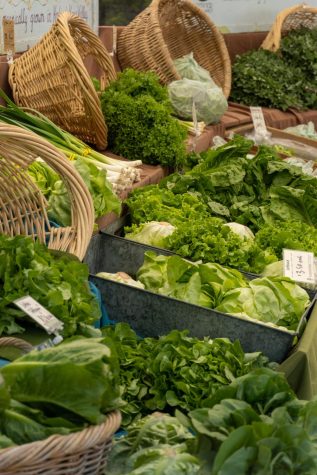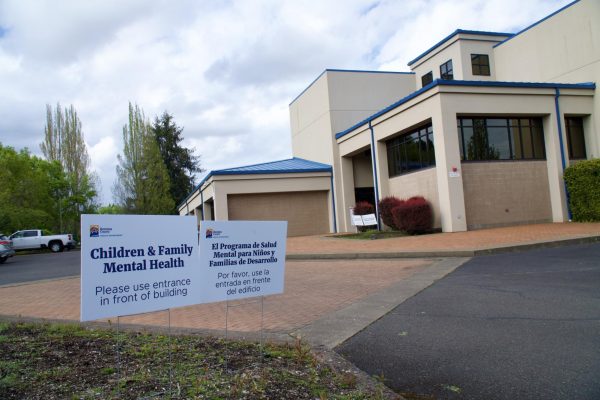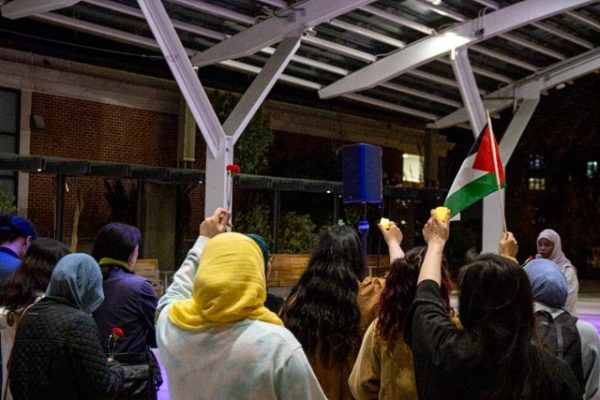Oregon State University fights food insecurity with a food share proposal
June 26, 2019
Edward J. Ray, Oregon State president, addressed the Corvallis community in a letter, explaining the plans coming to fruition the fall of 2020. Ray said that he is working with University Housing and Dining Services and the Human Services Resource Center to construct a plan to limit food waste, by repackaging the left over food made in the dining centers and making it available for students facing food insecurity.
“Over the summer, University Housing and Dining Services and HSRC managers will develop a pilot program to make available to eligible students food that has been produced in university dining centers, but at the end of a day, otherwise would go to waste,” said Ray in his letter addressed to the community.
Ray said that this program will work alongside the Linn Benton Food Share program that is already in affect. He said this program will then re-supply the packaged food from the dining halls to the HSRC food pantry.
Currently, they are trying to find a way to add this program to the Mealbux program, providing students who are within the food insecurity requirements with a meal card that they can use on campus, Ray said. OSU is also working to increase awareness of the programs that are currently fighting food insecurity, this will be seen through the Supplemental Nutrition Education Program said Ray.
“The goal of this program is to provide people eligible for food stamps and food assistance with information about making healthy food choices within limited budgets – and choose physically active lifestyles. Additionally, this work will make more students aware of how the HSRC can aid students to complete their applications for food assistance,” Ray said.
Ray said that this initiative will also be seen in the classroom, specifically the course syllabus. He said they will provide information about the importance of fulfilling basic needs and the programs that are currently available to help students, such as mental health, food insecurity and health services.
“Vice Provost Larson will create a task force in fall term 2019 made up of university administrators, faculty, student government leaders in Corvallis and Bend, students who served through our assistance programs, UHDS and financial aid representatives, and other university partners to develop additional action plans for implementation in 2020,” said Ray.
Ray said that according to the Hope Center for College, Community and Justice, almost half of all college students across the nation reported that they faced food insecurity in the past 30 days.
“This problem is striking close to home. Of the nearly 2,800 OSU students who applied for food assistance and food vouchers in the 2017-18 academic year, 81% met the federal definition of food insecurity,” Ray said in his letter addressed to the Corvallis community.
Ray said that food insecurity in students is caused by the costs of higher education, housing, utilities and groceries.
“The stark reality is that many students balance going to class and working multiple jobs to minimize college debt, and still don’t have enough money to attend class or take a test with the benefit of a recent nutritious meal,” Ray said in his letter addressing the community.Dan Larson, vice provost for student affairs, will be leading this program starting this fall, and will be initiated in the fall of 2020, said Ray. Also explaining that this program will play a larger role than the current programs fighting food insecurity, such as the Human Services Resource Center.
“Whatever the reason, the crisis of food deprivation at Oregon State must end. It is not acceptable for this university and for this state to have students in our OSU community that do not know where their next meal will come from,” said Ray.
However, their are current programs inacted by the Human Services Resource Center, working to fight food insecurity in students. This can be seen in the Mealbux program, Full Plate Funds, and the other informational resources provided on their website.
According to the Human Services Resource Center website, Mealbux is a program that supplies funds to students experiencing food insecurity. Mealbux can be spent anywhere on Oregon State campus that accepts orange cash.
“Mealbux is a food assistance program for OSU students funded by OSU student fees. Mealbux was created in 2009 for students who were struggling to buy meals for themselves and were having to choose between buying groceries and buying textbooks,” said the Human Services Resource Center website.
The Human Services Resource Center’s website said that students can donate funds from their meal plan to the Full Plate Fund, which allows students facing food insecurity to purchase food from any dining center with full plate funds.
“The HSRC distributes these donated funds to other residence hall students who are struggling to get enough to eat,” said the human services resource center website.
Other resourses featured on their website are makes cents meals, information on how to cook on a budget, how to stretch food stamps and The Mid-Valley Harvest. Makes Cents meals are meals designed to be nutritious and economically reasonable for students with meal plans, according to the human services resource center website.
“These have a $4.00 retail price, but on-campus residents save 25%, which means it costs $3.00,” said the human services resource center website. “If you have money on your ID card as Mealbux, Orange Cash, or Full Plate Funds, you can get a 10% discount (bringing the cost to $3.60).”
The HSRC website offers more information and resources on how to cook and purchase food on a budget, as well as, the availability to pick produce at Mid-Valley Farms. In the summer, food insecurity is a huge issue affecting students who are staying on for summer term. In order to combat this, the human services resource center is open throughout the week from 11-3pm, according to their website.
HSRC representative and worker, Breonna Keller-Robbins notes, “There are definitely very tentative things in the works for next year, but nothing is being exacted this summer.”
Keller-Robbins explains that there are four pantries available each month. The pantry has several styles, such as a shopping style, fresh food fridays, and emergency food boxes said Keller-Robbins.
“We have a shopping style pantry where patrons can come choose their own food choices, Fresh Food Friday’s where we provide a selection of produce from local farms, our garden and our food share partners,” said Keller-Robbins. “We also can provide community members and students with emergency food boxes where the staff pick out three days worth of food (three meals a day).”
According to Keller-Robbins, the HSRC food pantry obtains most of its edibles by donations made by the community. With this in mind Ray calls out to the community for donations to the annual Corvallis campus food drive.
As a community, I call upon us to expand the already impressive culture of caring within Oregon State University. That culture includes the annual Corvallis campus food drive. For example, the 2019 food drive raised the equivalent of 382,000 meals. Of that total, more than $67,000 in payroll contributions were made and another $55,000 was contributed in various food drive fundraising campus events.
“These contributions aid the OSU Food Pantry on the Corvallis campus in making a real difference,” said Ray.
“Approximately 65% of those served by the pantry are college students, and 93% of these households have at least one college student in their family. According to self-reported data from those served at the HSRC, 57% are first-generation students; 56% are students of color; and 158 reported sleeping in a tent, car or homeless shelter in the previous 12 months,” said Ray.























































































































